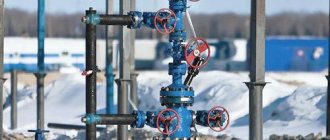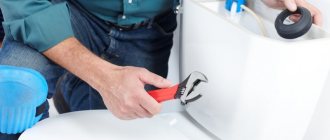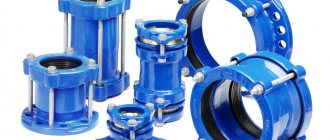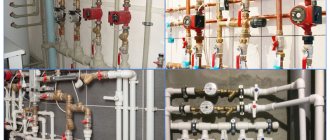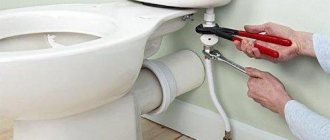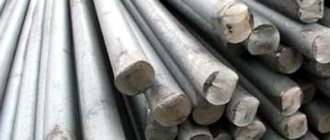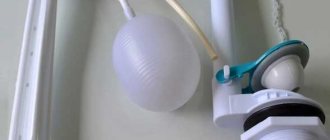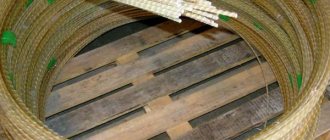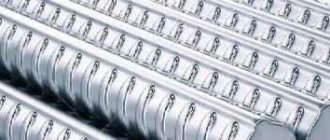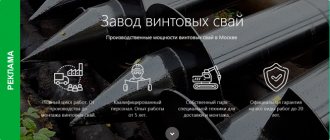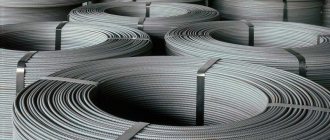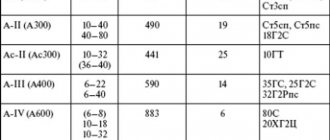Possibility of using check valves
This type of fittings is integrated into pipelines of various engineering networks. Most often, such valves are used in systems:
- Centralized water supply:
the device is used to prevent hot water from entering a cold pipeline in the event of a pressure drop. The check valve also protects the meters installed in front of it from water hammer, which can occur during the operation of faulty plumbing; - Autonomous water supply:
a mandatory component of such a system is a submersible pump that delivers water from the well. If it stops, water may flow in the opposite direction, which negatively affects the pumping equipment. A check valve helps prevent this phenomenon; - Autonomous heating:
coolant circulation in such systems is provided by pumps. A check valve must be installed in front of them. It prevents the outflow of water from the pipes when the pumping equipment is turned off, thereby ensuring the stability of the entire heating system; - In industrial networks:
check valves are actively used not only in everyday life, but also in industrial, utility and other enterprises. They are used as part of systems for various purposes. These can be both water pipelines and networks used to transport chemicals, wastewater, petroleum products and other things.
Purpose of the device
The water back pressure valve is designed to prevent water flow from being directed in the other direction. It has small dimensions and provides the necessary pressure in the pipeline.
Used for the following purposes:
In the water supply system. Installed on cold and hot water pipes in apartment buildings and private buildings. Normalizes the pressure in the system, providing the possibility of comfortable mixing of water and adjusting its temperature with a mixer.
In water heating systems. Boiler-type water heaters are filled with water under pressure. As the water heats up and increases, the flow tends back into the cold pipe. The check valve prevents water from being pushed back into the pipe.
In heating systems. Installed if the system consists of several circuits (water heater, heated floor, radiators), in which the flow parameters differ, to normalize the pressure.
In front of the counter. To protect the meter from failure due to pressure surges.
In water well systems powered by submersible pumps. Eliminates the possibility of water backflow after turning off the pump.
Types of check valves
Disc valves
This type of shut-off valve consists of a compact body and a valve made in the form of a disk (plate). Among all similar devices, these are the smallest. In addition, they are available in various designs.
Spring.
In such valves, the shutter disc is equipped with a spring. It presses the plate against the seat when the pressure in the system decreases, completely closing the hole. In normal operating condition, the disc is pressed out, creating conditions for the free flow of substance.
Bivalve.
Designed specifically for complex pipeline systems that are most susceptible to water hammer. A distinctive feature is a double-leaf disk that folds in half under the influence of the flow. With reduced water pressure, the valves open and are pressed against the seat, closing the diameter of the hole.
Reed (rotary) valves
They have a classic design, which is complemented by a shutter in the form of a spool valve. The axis of the locking element is located above the passage hole. When exposed to flow, the damper is constantly in a raised state. If the pressure in the system decreases, the spool moves down and closes the channel. Rotary valves are characterized by their unpretentiousness to the purity of the transported medium and the ability to work effectively in large-diameter pipes.
Today, this type of check valve is available in two versions.
- Simple.
They are fittings with a bore diameter of up to 400 mm. Designed for systems in which the resulting hydraulic shocks are not capable of causing significant damage to the pipeline or the valve itself. - Unstressed.
They are produced in the form of parts with a diameter of 400 mm, additionally equipped with a special mechanism that ensures smooth closing of the spool and eliminates the occurrence of a water shock wave when the valve is activated.
Ball valves
This type of fitting is a locking mechanism equipped with a ball-shaped shutter. In normal operating condition, it leaves the passage open; when the pressure drops, the ball drops and closes the hole. This valve is ideal for water supply, wastewater and sewerage pipelines. Valves with a ball locking element are inferior to their disk counterparts in terms of dimensions. However, it also has many advantages:
- resistance to sudden changes in pressure and temperature;
- safety and ease of operation;
- perfect tightness of the closed passage;
- minimal hydraulic resistance;
- multifunctionality and versatility.
Lift valves
This type of valve is distinguished by the presence of a valve, which is made in the form of a rising spool. Under the pressure of water, the shutter is constantly raised. When the pressure in the pipes drops, it drops onto the seat and blocks the flow. Such a valve is installed exclusively on horizontal sections of the pipeline system. In this case, it is imperative to ensure the accuracy of the vertical location of its spool.
Lift valves are very demanding regarding the cleanliness of the working environment. Another disadvantage is their high hydraulic resistance. However, these devices have a number of undeniable advantages:
- easy installation and the ability to dismantle for maintenance;
- accuracy of operation and tightness of closing the hole;
- compact dimensions and reliable design.
Choosing the right check valve
This type of fittings is selected in accordance with the characteristics and operational features of the pipeline system on which it will be installed. Today's range of check valves includes a wide variety of devices that differ in a number of parameters. Their key characteristics are:
- material:
cast iron, steel, stainless steel, brass, bronze; - operating pressure
- from 16 to 40 bar; - temperature regime
- up to +450 °C; - diameter
- from 15 to 800 mm.
Also, check valves differ in the type of mounting.
- Welding
– fixation is carried out using welding. This method is used in systems with aggressive environments. - Flange
- the valve is attached to the pipe using special fasteners equipped with seals. - Coupled
– performed with threaded couplings. Suitable for systems with small diameter pipelines. - Wafer
- carried out by clamping the valve between pipe flanges. Used in areas with small dimensions.
Naturally, when choosing a check valve, you need to take into account the design features of the device. Experts recommend using:
- for heating systems
- rotary valves, which are resistant to polluted environments and are able to ensure stable circulation of the coolant; - for water supply systems
- ball valves with coupling fastening, intended for small-diameter pipelines with a clean working environment; - for other “pure” systems made of metal-plastic
- spring valves with a butterfly valve, which have compact dimensions and effectively protect networks from water hammer.
Christmas tree fittings and their application
Christmas tree fittings are often used when laying pipelines, as well as when performing work of this kind, which takes place in various areas where drilling operations are necessary. This type of equipment should be considered in more detail.
Christmas tree fittings can have the following purposes. It is used for piping one or a number of pipelines, to control and control the flow of media in wells. With its help, you can carry out work on sealing wells, as well as make bends for flow lines. The use of this type of equipment greatly affects the productivity of work associated with laying pipelines.
Christmas trees are usually used in certain conditions, for example, in conditions of excess pressure created by large loads. It is also used when wells are likely to be exposed to aggressive environments. Quite often it is used under significant abrasive loads, when there are a large number of fractions of different rocks in the water. The use of christmas trees must be made taking into account the fact that this type of auxiliary equipment must have high strength and durability. This equipment is used in gas production and laying oil pipelines.
Fountain fittings have certain characteristics. It can be of different types, since GOST provides for its use in different conditions. The design of this type of equipment includes elements such as a fountain tree and pipe-type piping. Tying is carried out by directly tying one or more pipelines. The purpose of the piping is to manage and control the environment in the well, as well as in the space between the pipes. The fountain tree controls its well flow, and it is placed on the piping system.
Christmas tree fittings have a design feature that allows you to prevent and protect against any entry of pipeline contents into the soil, which ensures environmental protection. This type of equipment is equipped with various shut-off devices, as well as chokes. The pipe head is another structural element of the Xmas tree.
The design of the Xmas tree allows several rows of compressor-pump type pipes to be suspended from it. With the help of such fastening, free access to the space located behind the pipe is provided. Fountain fittings come in cross or tee types, each of which has certain advantages. Tee-type fittings allow repair work to be carried out on the structure without stopping the entire flow. Since this design is asymmetrical, the possibility of capsizing cannot be ruled out. The positive qualities of cross reinforcement are a high level of stability and compactness. However, there is also a drawback - it is impossible to carry out repairs while the well is operating.
Plumbing fittings have the same properties and characteristics as fountain fittings, with the difference that the working medium can only be water.
Features of installing check valves on pipelines
The variety of characteristics and design solutions determines the difference in the installation methods of this type of shut-off valve. When installing such valves, it is imperative to take into account the direction of flow inside the pipeline. There are special arrows on the product body that indicate the correct location of the device.
Depending on the valve selected, the following requirements must also be met.
- Wafer devices are placed and clamped between the pipeline flanges. Be sure to install seals between all components.
- The lift valve requires precise orientation along the vertical axis. Otherwise, the spool will operate incorrectly and ineffectively.
- Coupling valves are mounted by screwing onto pipeline threads using additional couplings and seals.
Check valve installation
A water check valve usually has a coupling design. This is the most popular variety. This valve is suitable for water supply and heating systems.
To install you need to follow a few simple steps:
- decide on the installation location. Usually installed in front of a meter or heating boiler;
- a sealant (FUM tape and the like) is wound onto the threaded sections of the fittings;
- the valve is secured with fittings. After installation, you need to check the system for leaks.
The valve always has an arrow indicating the direction of water flow. Be sure to mount the device in the appropriate direction. Otherwise, the valve will block the flow of water.
Pump for a summer residence: types, description of modern models, selection criteria and main parameters of the pump (125 photos)- World Print Company
Insulation of pipes - tips for choosing the optimal materials and methods for insulating water pipes (115 photos)
There are special valve models designed for sewer systems. They prevent waste and runoff from flowing back into the pipe.
Installation is carried out by inserting into the pipeline. The diameter of such valves can vary from 50 to 100 mm.
Advantages of modern check valves
Check valves produced today by domestic and foreign manufacturers have a carefully thought-out design and high efficiency. Their main advantages are:
- ability to operate stably at high pressure drops;
- minimum stroke of the shut-off element, reducing the time to shut off the flow;
- automatic activation when operating parameters of the system change;
- relatively small weight and dimensions;
- possibility of use in systems for various purposes;
- simple design, easy to maintain and repair;
- complete tightness of flow shutoff;
- excellent throughput;
- installation using various fastening technologies.
The correct selection and professional installation of a check valve, performed by qualified craftsmen, will reliably protect the pipeline and equipment from the harmful effects of water hammer, as well as ensure the stability of the system for many years.
